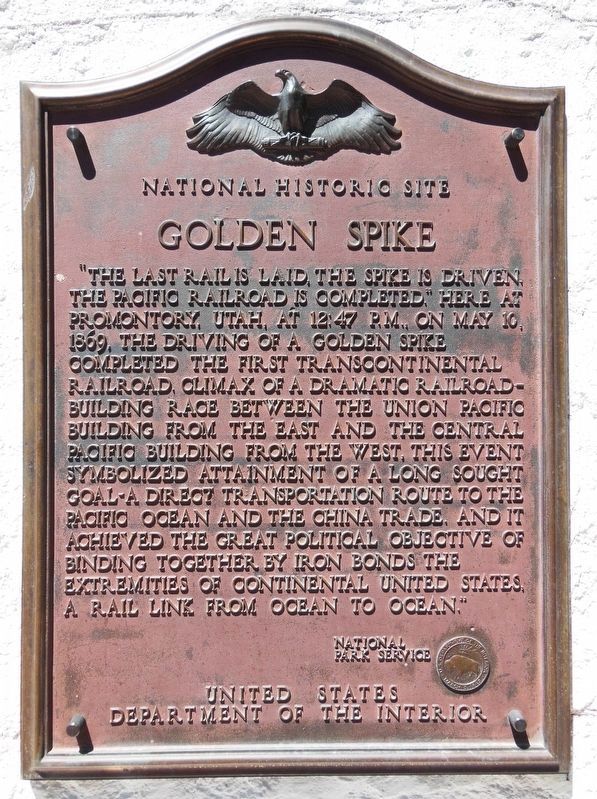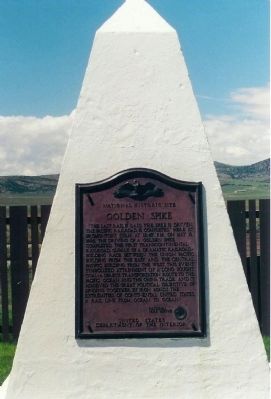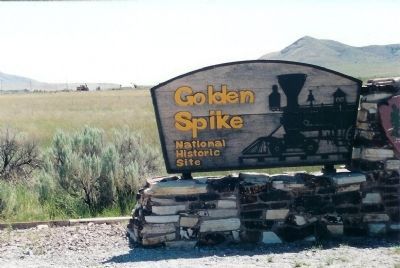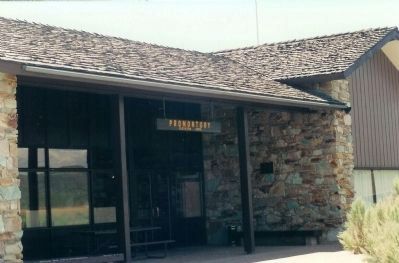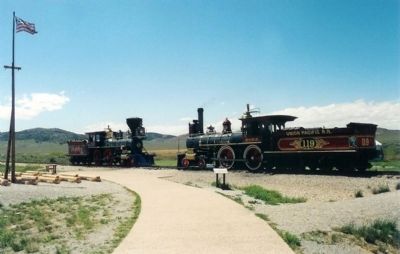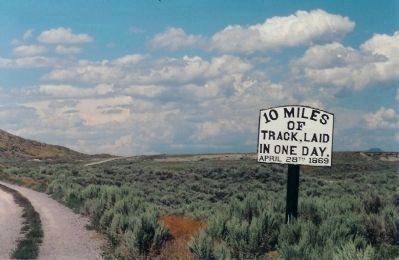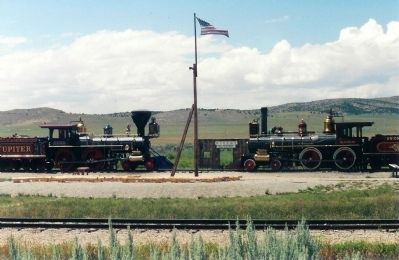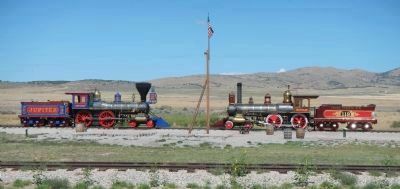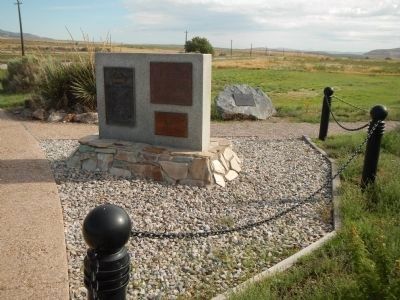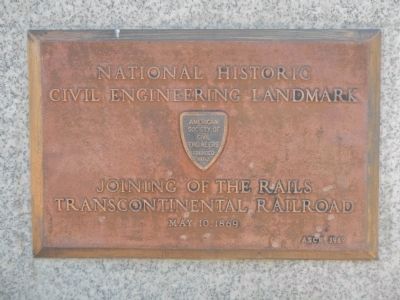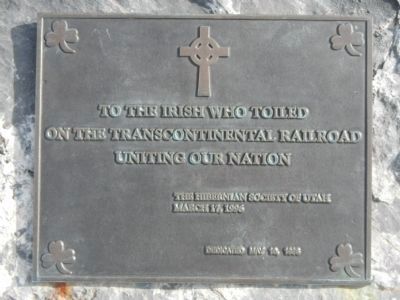Promontory Summit in Box Elder County, Utah — The American Mountains (Southwest)
Golden Spike
National Historic Site
"The last rail is laid, the spike is driven. The Pacific Railroad is completed." Here at Promontory, Utah, at 12:47 P.M. on May 10, 1869, the driving of a Golden Spike completed the first Transcontinental Railroad. Climax of a dramatic railroad-building race between the Union Pacific building from the east and the Central Pacific building from the west, this event symbolized attainment of a long sought goal - a direct transportation route to the Pacific Ocean and the China trade. And it achieved the great political objective of binding together by iron bonds the extremities of Continental United States, a rail link from ocean to ocean."
National Park Service
United States Department of the Interior
Erected by National Park Service.
Topics and series. This historical marker is listed in these topic lists: Notable Events • Railroads & Streetcars. In addition, it is included in the ASCE Civil Engineering Landmarks, and the Transcontinental Railroad series lists. A significant historical date for this entry is May 10, 1869.
Location. 41° 37.04′ N, 112° 33.049′ W. Marker is in Promontory Summit, Utah, in Box Elder County. Marker is on North 22300th Street West, on the right when traveling south. At the Golden Spike National Historic Site. Touch for map. Marker is at or near this postal address: 6200 North 22300th Street West, Corinne UT 84307, United States of America. Touch for directions.
Other nearby markers. At least 8 other markers are within walking distance of this marker. The Southern Pacific Monument (here, next to this marker); Stephen Tyng Mather (a few steps from this marker); Evolution of Rail (a few steps from this marker); Transforming Communication: from Coast to Coast (a few steps from this marker); Last Spike Driven (a few steps from this marker); Original Rail (within shouting distance of this marker); Irish Monument (within shouting distance of this marker); Competition 1869 (within shouting distance of this marker).
Regarding Golden Spike. One of the most dramatic events in the history of human achievement was the meeting of the Union Pacific and Central Pacific Railroads at Promontory, Utah on May 10, 1869. The meeting of these two railroads meant the joining of a continent. The 2000 miles from the Missouri River to the Pacific was reduced to six days travel time instead of six months. Additionally, the cost of traveling across the continent was reduced from approximately $1000 down to a mere $70. The public at that time was fully aware of the dramatic implications of the joining of the railroads. The fanfare revolving around the meeting of the railroads at Promontory, Utah was equivalent to the public reaction to the Moon landing a hundred years later in 1969.
When it became obvious in early 1869 that the Union Pacific and Central Pacific railroads would meet in the first half of that year, the newspapers around the country were filled with daily reports about each days progress in terms of rail laid and descriptions about the work. As the gap between the two railroads narrowed, it was apparent that the historic meeting would occur at the Promontory Point area of Utah which was in a level circular valley of about three miles diameter and surrounded by mountains.
In the days leading up to the meeting of the railroads, the rival work gangs of the two railroads competitively laid out rail at a pace that tried to outdo each other. One day the Union Pacific work crews would lay six miles of rails only to be outdone the following day by the mostly Chinese workers of the Central Pacific laying down seven miles of rails. Finally, the construction boss of the Central Pacific, Charles Crocker, boasted that his Chinese workers could lay down 10 miles of rail in one day. So confident was Crocker that this could be achieved that he bet $10,000 that it could be done and Thomas C. Durant, vice-president of Union Pacific took that bet. In an amazing feat, which has yet to be equaled even with today's modern techniques, the Central Pacific workers on April 28, 1869 were able lay the 10 miles of track in just 12 hours. This event helped to heighten the public’s awareness of the impending meeting of the two railroads in Promontory, especially since this feat brought them just a few miles from the appointed meeting point of the two railroads. Meanwhile, work crews from the Union Pacific set out to build the work camp at Promontory, which mostly meant construction of saloons and houses of prostitution.
The meeting of the railroads was originally scheduled for May 8, 1869 but because of a delay in the arrival of officials from the Union Pacific, it was re-scheduled to May 10. A little after eleven in the morning of that day, Governor Leland Stanford of California arrived in his Central Pacific train. Meanwhile the train from the Union Pacific was drawing closer as more rails were laid. At about noontime the trains were close enough that the last tie could be laid down. This tie was made of California laurel and had a silver plate in the middle engraved with the date and the names of the railroad officials of the two companies.
Also see . . .
1. Golden Spike National Historic Site. Utah Outdoor Activities website entry (Submitted on November 11, 2008, by Mike Stroud of Bluffton, South Carolina.)
2. Everlasting Steam: The Story of Jupiter and No. 119. National Park Service website entry (Submitted on November 11, 2008, by Mike Stroud of Bluffton, South Carolina.)
3. Golden Spike National Historic Park. National Park Service website entry (Submitted on November 11, 2008, by Mike Stroud of Bluffton, South Carolina.)
4. "Dot, Dot, Dot . . .Done" ::. Central Pacific Railroad Photographic History Museum website entry:
Many photos, news clippings, and other items. (Submitted on June 10, 2011.)
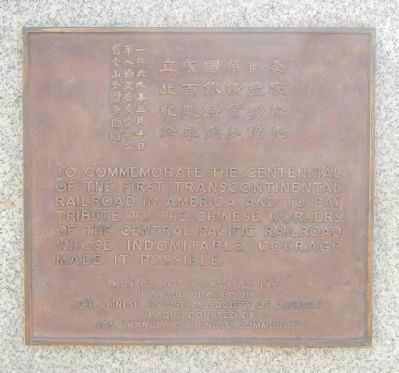
Photographed By Barry Swackhamer, August 27, 2014
10. Chinese Commemorative Plaque
May 10 1869 - May 10, 1969
Plaque placed by
The Chinese Historical Society of America
Plaque donated by
San Francisco Chinese Community
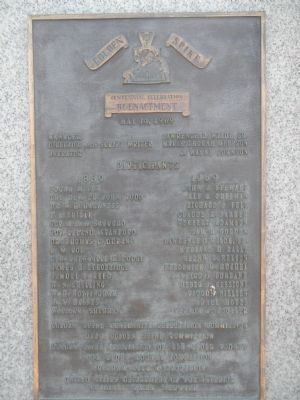
Photographed By Barry Swackhamer, August 27, 2014
12. Golden Spike Centennial Celebration Reenactment plaque
Centennial Celebration
Reenactment
May 10, 1969
Manager • Lawrence D. Wilde, Sr.
Director and Script Writer • Marie Thorne Jeppson
Narrator • J. Wayne Johnson
PARTICIPANTS (Cast)
1869 —— 1969
Edgar Mills • John J. Stewart
The Rev. Dr. John Todd • Alf L. Freeman
Dr. W,H, Harkness • Richard E. Felt
F.A. Tritle • Claude R. Barker
Gov. A.P.K. Safford • Herbert Adamson
Gov. Leland Stanford • San H. Gordon
Dr. Thomas C. Durant • Lawrence D. Wilde, Sr.
L.W. Cole • Myrland H. Balls
Gen. Grenville M. Dodge • Glenn S. Nelson
James H. Strobridge • Fredrick M. Huchel
Samuel B. Reed • A.L. (Gus) Burbank
W.N. Shilling • Heber J. Sessions
W.H. Nottingham • Vaughn Nielsen
J.W. Haines • Arnel Moyes
William Sherman • Vernon G. Poulter
Golden Spike Centennial Celebration Commission
Utah Golden Spike Commission
Golden Spike Association of Box Elder County
Box Elder County Commission
Brigham City Corporation
United States Department of the Interior
National Park Service
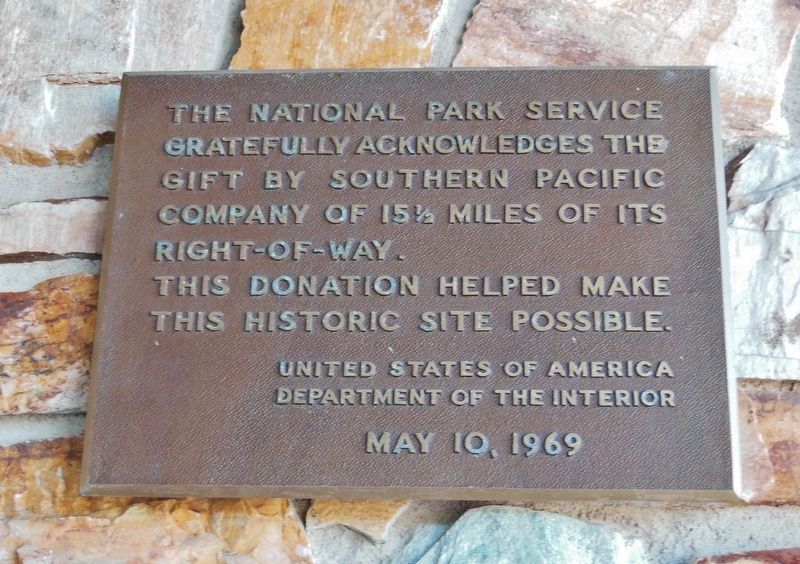
Photographed By Cosmos Mariner, June 17, 2013
14. Right of Way Acknowledgement Plaque
The National Park Service gratefully acknowledges the gift by Southern Pacific Company of 15 1/2 miles of its right-of-way.
This donation helped make this historic site possible.United States of America
Department of the Interior
May 10, 1969
This donation helped make this historic site possible.
Department of the Interior
May 10, 1969
Credits. This page was last revised on August 25, 2021. It was originally submitted on November 11, 2008, by Mike Stroud of Bluffton, South Carolina. This page has been viewed 3,793 times since then and 118 times this year. Last updated on May 10, 2019, by Craig Baker of Sylmar, California. Photos: 1. submitted on November 11, 2018, by Cosmos Mariner of Cape Canaveral, Florida. 2, 3, 4, 5, 6, 7. submitted on November 11, 2008, by Mike Stroud of Bluffton, South Carolina. 8, 9, 10, 11, 12, 13. submitted on February 22, 2015, by Barry Swackhamer of Brentwood, California. 14. submitted on November 11, 2018, by Cosmos Mariner of Cape Canaveral, Florida. • Andrew Ruppenstein was the editor who published this page.
